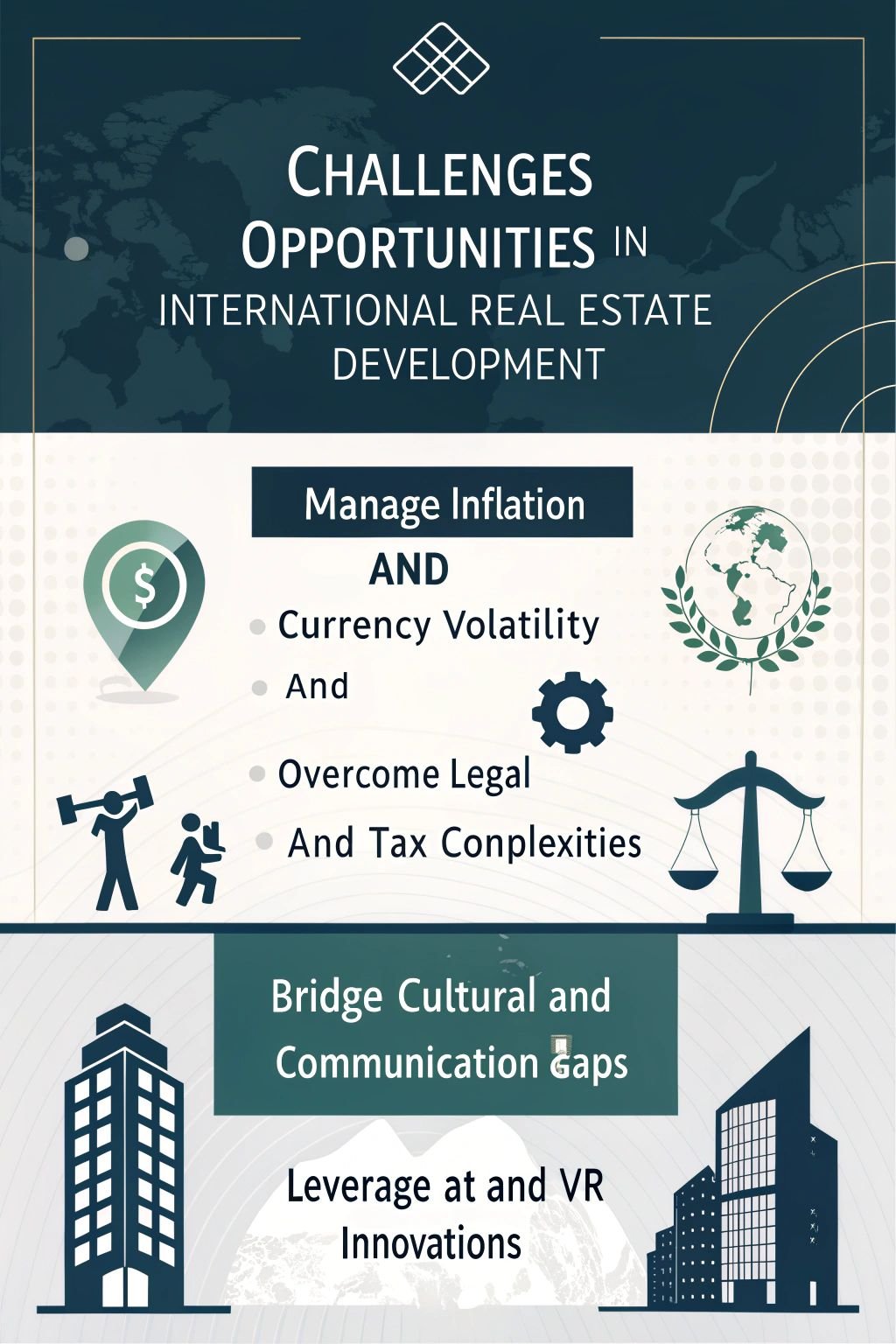Investing in international real estate can seem exciting, but it also comes with unique challenges. You might worry about currency fluctuations, legal issues, or managing risks in an unfamiliar market. 1 These concerns make global property investments feel overwhelming without proper guidance.
Cross-border transactions are increasing as investors look for opportunities in emerging markets and aim to diversify their portfolios. While these ventures offer high growth potential, they also require careful planning and thorough research to succeed. 3
This blog will help you address challenges such as market instability and legal frameworks while exploring how technology and sustainability create new opportunities for success. 2 Discover practical tips to manage risks and grow your international real estate portfolio with confidence.
Keep reading—your success starts here!
Key Takeaways
- Economic instability, such as inflation and exchange rate risks, affects returns on international investments. Risk management strategies can address these challenges effectively.
- Legal challenges often delay deals due to varying property rights and tax systems across borders. Around 30% of failed investments result from inadequate preparation for regulatory compliance.
- Cultural differences like language barriers or negotiation styles lead to communication gaps in cross-border transactions. Comprehensive research and collaboration with local partners help minimize these issues.
- Technology tools like AI enhance market trend predictions while VR enables remote property viewing, saving time and costs for investors globally.
- Green building practices reduce carbon emissions, decrease energy use by 40%, and appeal to eco-conscious buyers with long-term cost savings and government tax incentives.

Challenges and Opportunities in International Real Estate Development

Expanding into international real estate can bring both challenges and benefits. You may encounter political challenges or currency exchange rate fluctuations, but foreign investment trends often create opportunities for portfolio growth.
Economic fluctuations and market instability
Economic instability presents serious challenges to international real estate investors. Changes in local and global economies can decrease property values and rental income streams. 1 For instance, inflationary pressures or rising interest rates in emerging markets may lower returns on investments. Exchange rate risk also threatens portfolio growth when currency fluctuations weaken your investment value.
Market volatility brings both risks and opportunities for you as a foreign investor. Economic downturns might affect capital appreciation potential, but they could also create chances for asset acquisition at discounted prices.
Resilience during such times relies on strong market knowledge, thorough preparation, and effective currency risk strategies like hedging.
Legal hurdles often add to these financial risks by delaying transactions further.
Legal and regulatory hurdles
Legal and regulatory hurdles often make international real estate investing more challenging. Differing property rights across countries can limit foreign ownership, requiring you to thoroughly understand each nation’s legal framework.
For example, in some emerging markets, governments only permit investment in specific asset classes or enforce restrictions on cross-border transactions. Roughly 30% of failed investments occur because investors skip essential preparation or fail to comply with regulations. 2
Grasping local tax systems is crucial for managing financial risks. Property taxes, capital gains taxes, and other liabilities can significantly affect your return on investment. You must ensure all required documents—title deeds, purchase agreements, and due diligence reports—are accurate to avoid future disputes.
Locating trustworthy local partners such as attorneys or real estate agents ensures compliance with government policies while making the process more efficient.
Engaging professionals familiar with the market isn’t an option; it’s a necessity.
Dispute resolution methods vary by country as well. Whether through litigation or mediation, resolving issues may require additional time and costs depending on jurisdictional rules.
Challenges like these emphasize the importance of collaborating closely with experienced property managers and legal experts before agreeing to any international purchase.
Next comes examining cultural factors that influence expanding your portfolio globally…
Cultural and logistical complexities
Understanding local market dynamics shaped by cultural nuances is essential. Language barriers often affect communication between foreign investors, real estate agents, and property managers. 3 Misunderstandings may occur during cross-border transactions due to different customs or negotiation styles. Picture interacting with a target market in emerging economies where traditions influence buyer behavior—research and patience become your best tools.
Handling logistical challenges across borders requires thorough planning. Property management becomes complex with varying utilities, maintenance standards, and time zones. For example, coordinating rental income collection from retail outlets abroad may involve multiple contractual agreements or unexpected delays caused by inflation rates or currency fluctuations. 4 Building strong local partnerships can alleviate these challenges while improving efficiency across regions like the UAE or GCC countries.
Technological Advancements Shaping the Market

Technology is transforming international real estate investments with tools that simplify data-driven decisions. These innovations provide you with an advantage in analyzing market trends and making more informed property choices.
AI and big data analytics AI transforms how you approach international real estate investments. It improves property searches by analyzing your preferences and offering personalized recommendations. For investors, AI provides predictive analysis on market trends and growth rates, helping you identify opportunities in emerging markets or assess risk management strategies.
AI transforms how you approach international real estate investments. It improves property searches by analyzing your preferences and offering personalized recommendations. For investors, AI provides predictive analysis on market trends and growth rates, helping you identify opportunities in emerging markets or assess risk management strategies.
Integrating these tools into existing systems can be complex but offers long-term benefits for diversifying investments. 5
Big data analytics sharpens your decision-making process. By examining economic stability and currency exchange rates, it helps predict foreign exchange risks and political risks linked to cross-border transactions.
This allows you to discover competitive advantages while managing currency fluctuations effectively. Real estate professionals depend on this technology to stay ahead of trends impacting rental income or asset classes.
“AI doesn’t just analyze the present; it predicts the future,” says Chief Editor Jay Hernandez. 5
Virtual reality for property visualization
Virtual reality (VR) is transforming international real estate investing. You can now explore properties from your living room using immersive virtual tours, saving time and travel costs. 6 This technology helps you evaluate different asset classes like commercial real estate or rental income properties globally without stepping foot outside. VR also supports smarter decision-making by allowing you to visualize renovations or layout changes immediately.
Access to emerging markets becomes more feasible with VR. Sellers connect with international buyers more quickly, broadening their market reach and increasing portfolio growth opportunities for investors. 7 While limited access to VR headsets presents challenges, many see this as a minor obstacle considering the long-term benefits of improved market dynamics and cross-border transactions. 6The Role of Technology in Global Real Estate DevelopmentAI and big data analytics assist you in analyzing market dynamics, forecasting trends, and discovering profitable opportunities in international real estate investing. For example, emerging markets gain advantages from predictive tools that evaluate risk management and currency fluctuations, enabling you to make well-informed decisions for portfolio growth.
These advancements improve research processes and provide solutions for cross-border transactions. 8Blockchain technology enhances transaction security by minimizing fraud risks and ensuring clarity in financing options. You can depend on it to validate contracts or simplify asset class investments with greater efficiency. 9 The Internet of Things (IoT) also upgrades smart home systems by improving energy management and security features, boosting property value globally while addressing sustainability challenges.
Environmental Considerations and Sustainability in Development

Developers now concentrate on eco-friendly designs and smart urban layouts to address climate risks while fulfilling market demands for sustainable living.
Green building practices
Green building practices play a crucial role in modern real estate. These methods help reduce environmental harm while offering economic and social benefits.
- Lower Carbon Emissions
Real estate projects using green building designs significantly cut carbon emissions. Properties utilizing sustainable materials contribute to global goals of cleaner air. With the construction industry responsible for over 40% of greenhouse gas emissions, this change is vital. 10 - Energy Efficiency
Green homes consume 40% less energy compared to traditional properties. Using solar panels, LED lighting, and energy-saving appliances can lower utility bills. These choices also make properties more appealing for international real estate investment. - Long-Term Cost Savings
Sustainable buildings often have lower lifecycle costs due to minimal maintenance needs. Energy-efficient systems and durable materials reduce repair expenses over time. For investors focusing on rental income, these savings increase profit margins. - Tax Incentives
Governments offer tax breaks for eco-friendly developments in many markets. Investing in sustainable projects may lead to reduced tax liabilities or credits. For example, certain regions reward developers who implement green measures like water-efficient fixtures or renewable energy sources. - Increased Market Demand
Home buyers are actively interested in environmentally friendly properties due to health benefits and savings potential. Real estate professionals in emerging markets report higher demand for green-certified buildings as awareness grows globally. - Climate Resilience
Projects prepared for natural disasters and climate change risks retain value longer. Better urban planning includes flood-resistant structures or drought-tolerant landscaping, protecting assets from environmental challenges. - Appeal to Multinational Companies
Multinational companies leasing retail space often prefer green-certified buildings for their employees’ well-being and image enhancement efforts. Sustainable designs align with corporate responsibility goals. - Conservation of Resources
Efficient use of water systems helps conserve natural resources in areas prone to droughts or shortages like Dammam or other arid zones worldwide.
Urban planning for climate resilience
Urban planning plays a critical role in building climate resilience. As cities face increasing threats from climate change, smart planning protects investments and communities. 11
- Prioritize Green Infrastructure
Add parks, green roofs, and rain gardens to absorb stormwater and reduce flooding risks. These features enhance property values while improving air quality and biodiversity in urban areas. 12 - Adopt Sustainable Transportation Systems
Promote public transit, bike lanes, and walkable areas to reduce carbon emissions. Electric vehicle charging stations can attract eco-conscious buyers or tenants while lowering energy costs. - Prepare for Rising Sea Levels
Plan infrastructure to handle increased flood risks by using seawalls or elevated building designs. Coastal properties can retain their value with these proactive measures. - Use Renewable Energy Sources
Solar panels, wind turbines, and geothermal systems reduce reliance on fossil fuels. They support long-term economic stability while lowering operational costs for homeowners or real estate developers. - Design Climate-Resilient Buildings
Focus on energy-efficient architecture created with durable materials that withstand extreme weather conditions. These buildings save money on utilities and appeal to environmentally conscious investors. - Foster Public Awareness Programs
Educate communities about climate risks and actions they can take to build resilience. This awareness helps ensure smoother project approvals for international real estate investing efforts. - Encourage Mixed-Use Development
Plan neighborhoods that combine residential, commercial, and recreational spaces to reduce commute times and emissions while boosting local economies. - Collaborate with Policy Makers
Work directly with governments to align urban planning strategies with national goals like Vision 2030 or impact investments in emerging markets. - Integrate Smart Technology Solutions
Use AI tools to analyze weather patterns or evaluate risks for market volatility due to climate disruptions. This data strengthens risk management plans for real estate portfolios. - Support Affordable Housing Projects
Develop affordable housing built with sustainable methods to address growing demand in developing regions without compromising environmental goals or economic stability.
Efficient urban planning ensures your projects succeed despite future challenges posed by climate change impacts like rising temperatures or severe storms. 12
Conclusion

You encounter both challenges and opportunities in international real estate development. Market shifts, legal gaps, and cultural hurdles test your skills. Yet, tools like AI and virtual reality create possibilities for smarter investments.
Green building trends attract today’s sustainability-focused buyers. Achieving success relies on thorough research, local partnerships, and adapting to change.
FAQs
1. What are the main challenges in international real estate development?
Challenges include navigating legal and regulatory complexities, managing currency fluctuations, understanding cultural nuances, and dealing with market volatility in emerging markets.
2. How can investors manage risks in cross-border transactions?
Investors can use risk management strategies such as currency hedging, diversification of risk across asset classes, thorough due diligence, and forming local partnerships with trusted property managers or real estate agents.
3. What role do government policies play in international real estate investing?
Government policies impact economic stability, tax implications, financing options like mortgage loans, and compliance requirements that influence portfolio growth and overall investment success.
4. How does market research help when entering new markets?
Market knowledge allows investors to understand market dynamics like rental income potential or liquidity issues while identifying vulnerabilities such as overleveraging or exposure to climate change risks.
5. Why is currency diversification important for an international real estate portfolio?
Currency diversification reduces the impact of exchange rate changes on investments and helps maintain financial stability during periods of economic growth or downturns in specific regions.
6. What opportunities exist for professionals in emerging markets?
Emerging markets offer chances for portfolio expansion through affordable properties financed under favorable terms while benefiting from rapid economic growth driven by evolving infrastructure needs.
References
- ^ https://chordrealestate.com/blog/investing-in-international-real-estate-opportunities-and-risks
- ^ https://www.kennarealestate.com/blog/legal-and-regulatory-hurdles-in-international-real-estate-transactions/ (2024-09-10)
- ^ https://www.volcancapital.com/post/exploring-international-real-estate-investing-opportunities-and-challenges
- ^ https://www.sciencedirect.com/science/article/pii/S209044792400501X
- ^ https://www.researchgate.net/publication/378484087_Unleashing_the_Power_of_Artificial_Intelligence_in_Real_Estate_Valuation_Opportunities_and_Challenges_Ahead (2024-02-14)
- ^ https://abrillianttribe.com/virtual-reality-in-real-estate-revolutionizing-property-showings/
- ^ https://www.researchgate.net/publication/372676021_THE_IMPLEMENTATION_OF_VIRTUAL_REALITY_VR_TECHNOLOGY_IN_REAL_ESTATE_INDUSTRY
- ^ https://www.springbord.com/blog/impact-of-technology-on-real-estate/
- ^ https://www.linkedin.com/pulse/role-technology-modern-real-estate-avinash-dubey-ka5ec
- ^ https://www.mdpi.com/2071-1050/14/21/14393
- ^ https://www.preventionweb.net/files/18315_sustainableurbandevelopmentbackgrou.pdf
- ^ https://www.researchgate.net/publication/376592150_Building_Climate_Resilience_Through_Urban_Planning_Strategies_Challenges_and_Opportunities





















